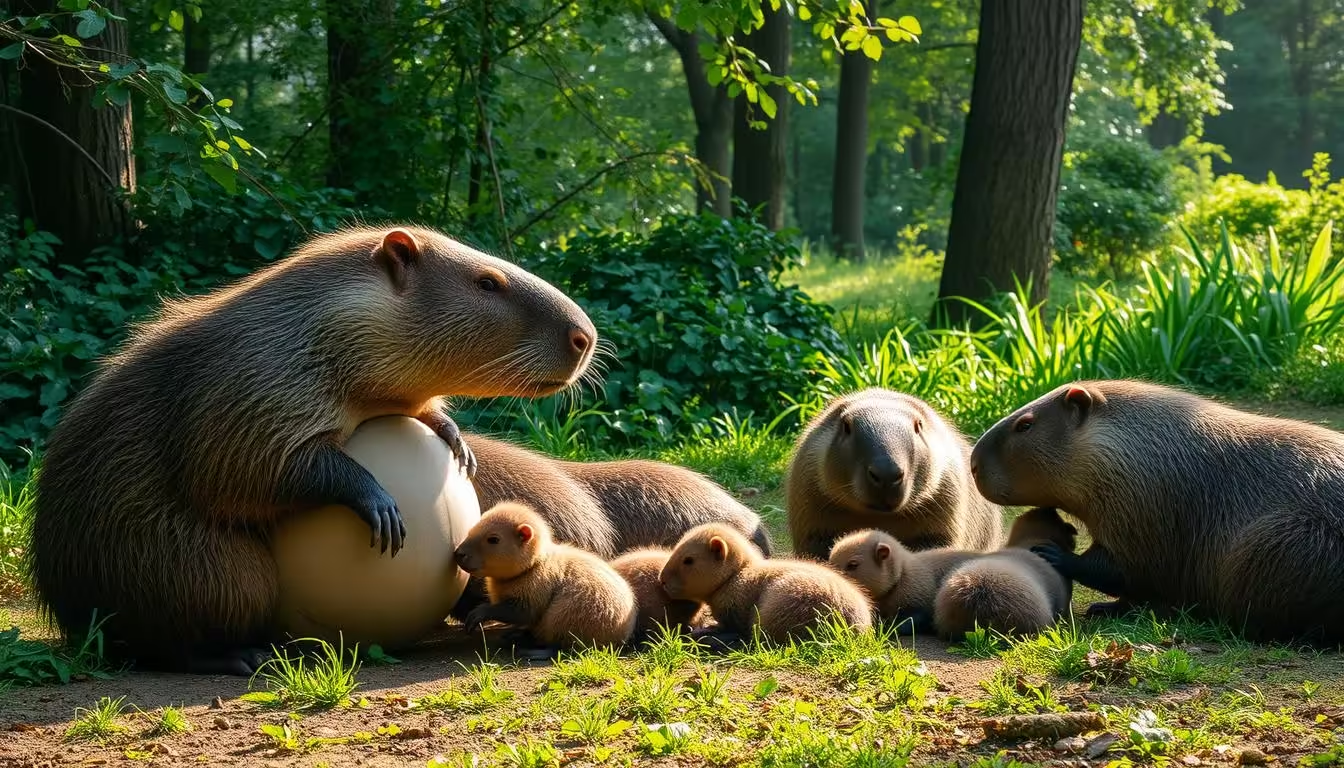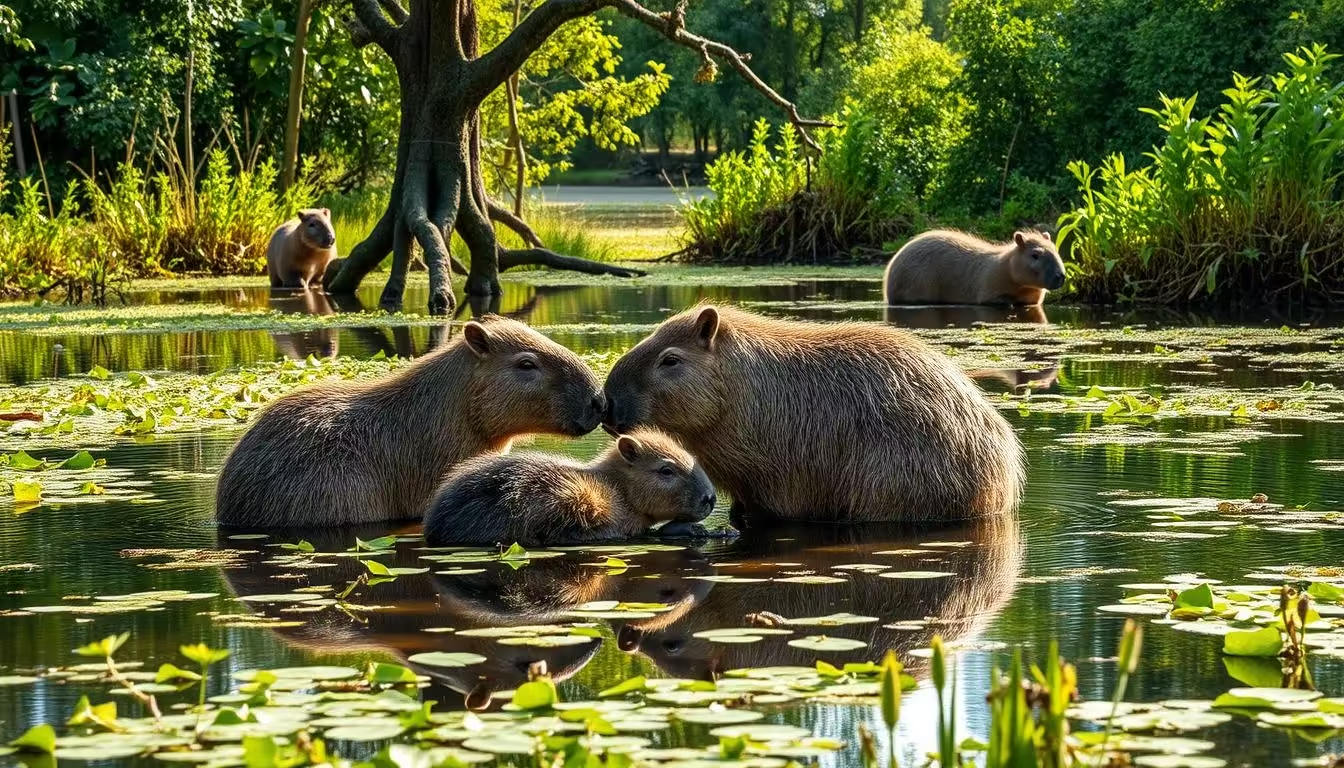Capybaras social lives and big bodies are especially fascinating. One key thing about capybaras is how breeding affects their lifespan. Knowing this helps us understand their health better.
Key Takeaways
- Female capybaras in the wild have an average lifespan of 6 to 10 years.
- Captive female capybaras can live up to 12 years on average.
- Breeding and pregnancy can have a significant impact on a female capybara’s health and longevity.
- Reproductive stress and the physical demands of breeding can affect a female capybara’s lifespan.
- Optimal breeding age and frequency are crucial for maintaining the overall health and well-being of female capybaras.
Understanding Female Capybara Biology and Natural Lifespan
The capybara is known for its unique biology and long life. Female capybaras are a bit bigger than males, weighing 35 to 66 kg and being 1.2 meters long. Their reddish-brown fur with a yellowish belly shows they’re adapted to wetlands.
Average Life Expectancy in Wild vs Captivity
In the wild, female capybaras live about 6 years, with a max of 10. But in captivity, they can live up to 12 years. This shows how care and protection can extend their lives.
Physical Characteristics of Female Capybaras
Capybaras have a strong body and unique traits. Females are ready to breed between 7 to 12 months old. They can have litters of 2 to 8 young, with an average of 4.
Natural Aging Process in Female Capybaras
The aging process of female capybaras is affected by many things. These include predators, the environment, and the demands of breeding. Knowing about capybara biology and lifespan is key for wildlife biologists and conservation. It helps protect these rodent longevity champions of the South American semi-aquatic mammals ecosystem.
“Capybaras are fascinating creatures that have adapted remarkably well to their wetland habitats. Their unique biology and impressive longevity make them a valuable subject for wildlife biology research.”
The Role of Breeding Cycles in Capybara Health
Capybaras are polyestrous rodents, meaning they have multiple estrous cycles throughout the year. Their estrous cycle lasts about 7.5±1.2 days. They are receptive for at least 8 hours. Breeding happens all year, but peaks at the start of the rainy season. Females can have up to two litters per year under good conditions.
The breeding cycle is key to female capybara health. Hormonal changes, pregnancy stress, and lactation energy needs can affect their health. It’s vital to understand how breeding cycles impact capybara health to ensure their well-being.
| Breeding Cycle Characteristics | Impact on Female Capybara Health |
|---|---|
| Polyestrous with spontaneous ovulation | Hormonal fluctuations can affect metabolic processes and overall physiology |
| The estrous cycle lasts 7.5±1.2 days | Repeated cycles can lead to physical and reproductive stress |
| Peak breeding at the start of the rainy season | Increased energy demands to support gestation and lactation |
| Potential for two litters per year | Successive pregnancies can strain the female’s body and resources |
Understanding the link between capybara breeding cycles and health helps support these remarkable rodents. This knowledge aids in developing effective strategies for their care in both captive and wild settings.
Does Breeding Affect the Lifespan of Female Capybaras?
The impact of breeding on female capybara lifespan is complex. Capybaras are prolific breeders, but breeding can harm their health. The physical demands of multiple pregnancies can affect their long-term health and lifespan.
Impact of Multiple Pregnancies
Female capybaras can breed all year, with a peak in the rainy season. Each pregnancy lasts about 150 days. They can have up to two litters a year, which is stressful for their bodies.
Hormonal Changes During Breeding
Hormonal changes during breeding can affect female capybaras’ health. Changes in estrogen and progesterone can weaken their immune system and increase health risks.
Recovery Periods Between Births
Female capybaras need time to recover between births. If they don’t get enough rest, they can become weak and develop health problems. This can shorten their lifespan.
The relationship between breeding, hormones, and physical strength is key to female capybara longevity. Understanding this can help in managing their health and survival.
Optimal Breeding Age and Frequency for Female Capybaras
Capybaras, the world’s largest rodents, have a unique reproductive biology. Female capybaras reach sexual maturity between 12 to 24 months. Males become sexually mature around 24 to 36 months. In the wild, they usually have one litter per year. But in captivity, they can have up to two litters annually under favorable conditions.
The optimal breeding frequency for female capybaras balances their reproductive output with their long-term health and longevity. Nutrition, environmental conditions, and social structure can significantly influence breeding success and frequency. Capybaras have a gestation period ranging from 91 to 111 days. They give birth to an average of 2 offspring, with a range of 1 to 4 young per litter.
Capybara cubs are altricial, requiring substantial parental care and protection until they become independent between 1.75 to 2.5 years old. Female capybaras provide this crucial guidance and support to their offspring until they reach near-adult age. In the wild, capybaras typically have a lifespan of 11 to 12 years. But in captivity, they can live over 20 years.
Understanding the optimal breeding age and frequency for female capybaras is essential for wildlife biologists and conservation efforts. By balancing reproductive output with the females’ long-term health, we can ensure the sustainability of capybara populations. This promotes their overall well-being in both captive and natural environments.
Maternal Health Considerations During Pregnancy
Pregnancy is a key time for female capybaras, the largest rodent. They need more nutrients and face physical stress. Knowing their needs is key for their health and the bond with their babies.
Nutritional Requirements
Pregnant capybaras need more nutrients for their babies and for milk production. They eat grasses, plants, and sometimes bark and fruits. A balanced diet is vital for the mother and her growing baby.
Physical Stress Factors
Pregnancy is hard on female capybaras. They gain weight, need more energy, and face dangers. Keeping them safe is crucial for their health.
Good food and a safe place are essential for pregnant capybaras. By meeting their needs, we help this amazing rodent species thrive.
“The bond between mothers and their offspring is crucial for individual development in various mammalian species.”
| Nutrient | Importance for Pregnant Capybaras |
|---|---|
| Protein | Supports fetal growth and tissue development |
| Calcium | Necessary for bone and tooth formation in offspring |
| Iron | Prevents anemia and supports maternal energy levels |
| Omega-3 fatty acids | Promote brain and eye development in fetuses |
Impact of Environmental Conditions on Breeding Success
The breeding success of capybaras, the world’s largest rodents, is heavily influenced by their environment. They live in habitats near water, like flooded grasslands and marsh edges. This is where they find plenty of food and protection.
Seasonal changes are key to capybara breeding patterns. They breed most during the rainy season. This is when water, food, and other factors are best for them. Water levels, vegetation, and predators can greatly affect their breeding success, both in the wild and in captivity.
| Environmental Factor | Impact on Capybara Breeding |
|---|---|
| Water Availability | Capybaras need water for drinking, cooling, and protection. Enough water is crucial for their breeding success. |
| Food Resources | Capybaras eat plants like grasses and aquatic plants. The availability of these foods affects their breeding and survival. |
| Predation Pressure | Predators like jaguars, pumas, and caimans threaten capybaras, especially during breeding seasons when they are more vulnerable. |
| Captive Conditions | In captivity, things like enclosure size, group composition, and management practices greatly impact capybara breeding success. |
Understanding how environmental conditions affect capybara reproduction is key. This knowledge is vital for wildlife biologists and conservationists. They work to manage and protect these fascinating South American semi-aquatic mammals.
Climate change and human activities are changing natural habitats. This makes it harder to keep the right balance for capybara reproduction. Wildlife biology professionals face a big challenge. They must ensure the survival of these iconic South American semi-aquatic mammals.
Social Structure and Its Effect on Female Longevity
Capybaras, the world’s largest rodents, live in complex societies. They form groups of 3 to 30, gathering near water in dry seasons. Males dominate, while females focus on caring for the young together.
Hierarchical Dynamics
The social hierarchy affects female capybaras’ lives. Dominant females get the best spots and food. This can help them stay healthy. But, the stress of keeping status can shorten their lives.
Group Size Impact
Group size matters for female capybaras. Big groups offer safety and help. But, small groups face more dangers and have less support. This can shorten their lives.
| Trait | Wild Capybara | Captive Capybara |
|---|---|---|
| Average Lifespan | 4 years | 8-10 years |
| Group Size | 3-30 individuals | Varies, often smaller groups |
| Hierarchical Structure | Strict, with dominant females | Maybe less pronounced |
In conclusion, the capybara social structure greatly affects female longevity. Factors like hierarchy, resource access, and group size are key. Understanding these aspects is vital in wildlife biology and capybara reproduction.
Reproductive Stress and Physical Demands
Female capybaras, the world’s largest rodents, face big challenges in their lives. They have a long pregnancy of about 150 days. Then, they nurse their young for about 16 weeks.
These amazing creatures can have 2 to 8 pups at a time, with an average of 4. The stress of carrying and nursing these young can harm their health. Repeated pregnancies without enough rest can shorten their lives.
The capybara’s reproductive biology shows their amazing ability to adapt. But, the stress of breeding can affect their health a lot. It’s key to understanding capybara reproduction and wildlife biology to help these animals thrive.
“Captive capybaras engage in complex social interactions, establishing dominance hierarchies within groups through aggressive displays, vocalizations, and physical contests.”
It’s important to balance the needs of female capybaras with their reproductive cycle. This is vital for wildlife biology and conservation. By understanding their challenges, we can help keep these amazing creatures healthy and alive.
Management Strategies for Breeding Females
To manage breeding female capybaras well, you need to focus on their health and diet. These steps are key to keeping them healthy and long-lived.
Healthcare Protocols
It’s important to have regular health checks and control parasites. Also, reducing stress is crucial. Veterinarians should watch their health closely and help them stay healthy.
Dietary Requirements
Capybaras eat grasses, aquatic plants, and sometimes supplements. In captivity, they need a balanced diet. This diet supports their health and helps them live longer.
Also, the size of their enclosures and social groups matter. These factors can help them breed better and live longer. By using these strategies, we can help these amazing animals thrive.
“Effective management strategies for breeding female capybaras are essential to ensure their well-being and longevity, ultimately contributing to the conservation of this unique wildlife biology species.”
Comparing Wild and Captive Breeding Impacts
Captive breeding of capybaras can greatly affect their lifespan and health compared to wild ones. Wild capybaras usually have one litter a year. But, captive ones can have up to two litters annually under the best conditions. This higher breeding rate in captivity can help females live longer due to better diets, healthcare, and less risk of being hunted.
Captive-born capybaras often live longer than their wild counterparts. They are safer from dangers found in nature. Also, captive breeding can use new research in rodent longevity and capybara reproduction to help these animals thrive.
But, the captive setting can also bring its own stressors. Things like social issues, competition for resources, and being confined can affect their health and lifespan. It’s important to understand these differences to make sure the species can be saved and bred successfully in the long run.



